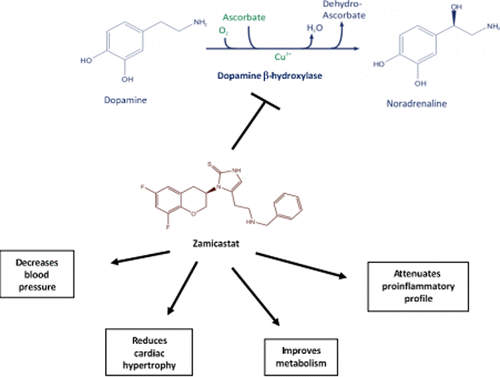当前位置:
X-MOL 学术
›
ACS Pharmacol. Transl. Sci.
›
论文详情
Our official English website, www.x-mol.net, welcomes your
feedback! (Note: you will need to create a separate account there.)
Cardiometabolic and Inflammatory Benefits of Sympathetic Down-Regulation with Zamicastat in Aged Spontaneously Hypertensive Rats.
ACS Pharmacology & Translational Science ( IF 4.9 ) Pub Date : 2019-09-16 , DOI: 10.1021/acsptsci.9b00039 Bruno Igreja 1 , Nuno Pires 1 , Ana Loureiro 1 , Lyndon Wright 1 , Patrício Soares-da-Silva 1, 2, 3
ACS Pharmacology & Translational Science ( IF 4.9 ) Pub Date : 2019-09-16 , DOI: 10.1021/acsptsci.9b00039 Bruno Igreja 1 , Nuno Pires 1 , Ana Loureiro 1 , Lyndon Wright 1 , Patrício Soares-da-Silva 1, 2, 3
Affiliation

|
The hyperactivity of the sympathetic nervous system (SNS) plays a major role in the development and progression of several cardiovascular diseases. One strategy to mitigate the SNS overdrive is by restricting the biosynthesis of norepinephrine via the inhibition of dopamine β-hydroxylase (DBH). Zamicastat is a new DBH inhibitor that decreases norepinephrine and increases dopamine levels in peripherally sympathetic-innervated tissues. The cardiometabolic and inflammatory effects of sympathetic down-regulation were evaluated in 50 week old male spontaneously hypertensive rats (SHRs) receiving zamicastat (30 mg/kg/day) for 9 weeks. After 8 weeks of treatment, the blood pressure (BP) and heart rate (HR) were assessed by tail cuff plethysmography. At the end of the study, 24 h urine, plasma, heart, and kidney were collected for biochemical and morphometric analyses. Zamicastat-induced sympathetic down-regulation decreased the high BP in SHRs, with no observed effect on HR. The heart-to-body weight ratio was lower in SHRs treated with zamicastat, whereas the body weight and kidney-to-body weight ratio were similar between both SHR cohorts. Zamicastat-treated SHRs showed reduced 24 h urine output, but the urinary amount of protein excreted and creatinine clearance rate remained unchanged. Zamicastat treatment significantly decreased plasma triglycerides, free fatty acids, and aspartate aminotransferase levels. Aged SHRs showed higher plasma levels of inflammatory markers as compared with age-matched normotensive Wistar-Kyoto rats. The inflammatory benefits attained with DBH inhibition were expressed by a decrease in CRP, MCP-1, IL-5, IL-17α, GRO/KC, MIP-1α, and RANTES plasma levels as compared with untreated SHRs. In conclusion, DBH inhibition decreased norepinephrine levels, reduced end-organ damage, and improved cardiometabolic and inflammatory biomarkers in aged male SHRs.
中文翻译:

扎米卡司他下调交感神经对老年自发性高血压大鼠的心脏代谢和炎症益处。
交感神经系统(SNS)的过度活跃在多种心血管疾病的发生和发展中发挥着重要作用。缓解 SNS 过度驱动的一种策略是通过抑制多巴胺 β-羟化酶 (DBH) 来限制去甲肾上腺素的生物合成。 Zamicastat 是一种新型 DBH 抑制剂,可降低外周交感神经支配组织中的去甲肾上腺素并增加多巴胺水平。在接受扎米司他(30 mg/kg/天)9周的50周龄雄性自发性高血压大鼠(SHR)中评估交感神经下调的心脏代谢和炎症影响。治疗8周后,通过尾套体积描记法评估血压(BP)和心率(HR)。研究结束时,收集 24 小时尿液、血浆、心脏和肾脏进行生化和形态测定分析。扎米卡司他诱导的交感神经下调降低了 SHR 中的高血压,但没有观察到对 HR 的影响。接受扎米卡司他治疗的 SHR 的心脏与体重比较低,而两个 SHR 队列之间的体重和肾脏与体重比相似。扎米卡司他治疗的SHRs显示24小时尿量减少,但尿蛋白排泄量和肌酐清除率保持不变。扎米卡司他治疗显着降低血浆甘油三酯、游离脂肪酸和天冬氨酸转氨酶水平。与年龄匹配的正常血压 Wistar-Kyoto 大鼠相比,老年 SHR 显示出更高的血浆炎症标志物水平。与未经治疗的 SHR 相比,DBH 抑制所带来的炎症益处表现为 CRP、MCP-1、IL-5、IL-17α、GRO/KC、MIP-1α 和 RANTES 血浆水平降低。 总之,DBH 抑制降低了老年男性 SHR 的去甲肾上腺素水平,减少了终末器官损伤,并改善了心脏代谢和炎症生物标志物。
更新日期:2019-09-16
中文翻译:

扎米卡司他下调交感神经对老年自发性高血压大鼠的心脏代谢和炎症益处。
交感神经系统(SNS)的过度活跃在多种心血管疾病的发生和发展中发挥着重要作用。缓解 SNS 过度驱动的一种策略是通过抑制多巴胺 β-羟化酶 (DBH) 来限制去甲肾上腺素的生物合成。 Zamicastat 是一种新型 DBH 抑制剂,可降低外周交感神经支配组织中的去甲肾上腺素并增加多巴胺水平。在接受扎米司他(30 mg/kg/天)9周的50周龄雄性自发性高血压大鼠(SHR)中评估交感神经下调的心脏代谢和炎症影响。治疗8周后,通过尾套体积描记法评估血压(BP)和心率(HR)。研究结束时,收集 24 小时尿液、血浆、心脏和肾脏进行生化和形态测定分析。扎米卡司他诱导的交感神经下调降低了 SHR 中的高血压,但没有观察到对 HR 的影响。接受扎米卡司他治疗的 SHR 的心脏与体重比较低,而两个 SHR 队列之间的体重和肾脏与体重比相似。扎米卡司他治疗的SHRs显示24小时尿量减少,但尿蛋白排泄量和肌酐清除率保持不变。扎米卡司他治疗显着降低血浆甘油三酯、游离脂肪酸和天冬氨酸转氨酶水平。与年龄匹配的正常血压 Wistar-Kyoto 大鼠相比,老年 SHR 显示出更高的血浆炎症标志物水平。与未经治疗的 SHR 相比,DBH 抑制所带来的炎症益处表现为 CRP、MCP-1、IL-5、IL-17α、GRO/KC、MIP-1α 和 RANTES 血浆水平降低。 总之,DBH 抑制降低了老年男性 SHR 的去甲肾上腺素水平,减少了终末器官损伤,并改善了心脏代谢和炎症生物标志物。











































 京公网安备 11010802027423号
京公网安备 11010802027423号